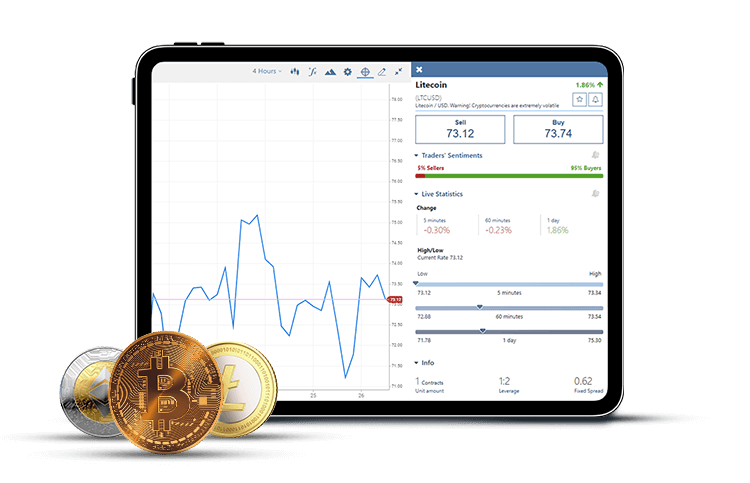How to Buy, Sell, and Trade Cryptocurrencies
Date Modified: 13/08/2025
There is a difference between buying/selling cryptocurrencies on an exchange and trading cryptocurrency CFDs on a CFD platform like Plus500. Both activities are undertaken with the intention of making a profit by trading in the crypto market, but the processes involved are very different, and so are the advantages and disadvantages. This article describes how to buy and sell cryptos as well as how to trade cryptocurrency CFDs.

Illustrative prices.
TL;DR
- Approaches: Exchanges involve buying actual cryptocurrencies, while CFDs trade on price movements without owning the assets.
- Leverage: CFDs offer leverage for amplified gains or losses; exchanges rely on price increases only.
- Processes: Exchanges use wallets for trading crypto pairs; CFDs use traditional currencies for deposits and bi-directional trading.
- Risk Tools: CFD platforms like Plus500 provide tools like stop-loss to manage high market volatility.
First, before getting down to the nitty-gritty of cryptocurrency buying through an exchange and trading cryptocurrency CFDs, let us take a look at the overarching differences between the two options:
Cryptocurrency CFDs |
Crypto Exchanges |
|---|---|
Potentially more security and protection from hacker attacks since you don't own the cryptocurrency. Instead, you trade CFDs on the prices of cryptocurrencies. |
You have to save your cryptocurrencies in "crypto wallets." This may mean that your crypto can become more prone to hacking attacks. |
CFDs are leveraged derivatives. This means that you may maximise your gains with a smaller initial margin. However, this also means that your losses can be also magnified. |
No leverage. |
Ability to trade on upward and downward price changes: When trading cryptocurrency CFDs, you can either go long or buy when there's a bullish crypto market, or when there's a bearish price movement, you can go short and sell. |
You only profit from the increases in the prices of your cryptocurrency. |
No actual ownership of the cryptocurrency. |
You get full ownership of the cryptocurrency. |
Buying and Selling Cryptocurrencies
Buying and selling digital cryptocurrencies may involve using one cryptocurrency, such as Bitcoin, to exchange it for another cryptocurrency, such as Ethereum, on a buy or sell basis, working on a cryptocurrency exchange. The process involves looking for a cryptocurrency pair in order to perform a crypto-to-crypto exchange or exchanging crypto for currency for cryptos. The transaction is done twice, and in opposite directions to complete an exchange cycle with the goal of profiting from the exchange.
Trading Venue
The buying and selling of cryptocurrencies is done on cryptocurrency exchanges. A trader needs to open an exchange account by filling out an online form. Most exchanges feature an order book that will indicate what traders are buying and selling and where they are doing this.
Making Deposits and Withdrawals When Trading Cryptocurrencies
Cryptocurrency exchanges usually accept deposits and withdrawals in two ways. A small number of exchanges (mostly found in the US and UK) accept fiat currency deposits or a mix of fiat and cryptocurrency methods. However, the majority of exchanges across the world accept crypto-based methods of transaction due to restrictions placed by banks on such exchanges in operating bank accounts. If the exchange only accepts cryptocurrency deposits/withdrawals, the trader must additionally create a third-party wallet for the cryptocurrency to be used to perform the deposits. The most common cryptocurrencies used for deposits are Bitcoin, Ethereum, and Litecoin.
To deposit funds, one would need to purchase BTC, ETH or any other deposit cryptocurrency from third-party sources and have it transferred to their third-party wallet. The funds are then transferred from this wallet to the wallet provided by the crypto exchange for depositing that cryptocurrency. If you choose to use this method, you should ensure that you enter the wallet addresses properly when conducting the transactions, as any crypto transferred to the wrong address cannot be recovered.
The Process of Trading Cryptocurrencies
Once your exchange wallet has been credited, you can buy and sell cryptos by trading the pairs that contain the deposit currency you have chosen. BTC and ETH usually have the largest number of pairings on any exchange, you will be able to use Limit orders ('Close at Profit'), Stop Loss orders ('Close at Loss'), or future orders to Buy/Sell your preferred digital cryptos.
Trading Cryptocurrency CFDs
Trading cryptocurrencies can be done on a speculative basis, usually by trading on the prices of cryptos via contracts for difference (CFDs). Here, the actual cryptocurrencies are not actually owned or exchanged by the trader. The process involves buying or selling contracts based on the price movements of the underlying cryptocurrency in question. This can be helpful to traders seeking access to the world of cryptocurrencies without owning them. Through trading cryptocurrency CFDs, traders can access the crypto market without finding a crypto wallet to store the crypto coins to keep them safe from possible hacking attacks. In addition, cryptocurrency CFDs are leveraged derivatives which means that traders can trade cryptocurrencies with a smaller initial margin, thus potentially magnifying their gains or losses.
Nevertheless, while trading crypto CFDs can come with its advantages, you should keep in mind that CFDs are highly volatile instruments and that leverage can often be a double-edged sword because it can magnify losses if a trade goes against you. In an attempt to mitigate your losses, you can always use risk management tools (visit our Risk Management page), like stop-loss, guaranteed stop, and trailing stop, which are available on Plus500's trading platform.
Where Can I Trade Cryptocurrency CFDs?
Trading of cryptocurrency CFDs is done via online platforms of CFD providers like Plus500. The trader needs to open an account by filling out an online form. Identity and residence address verification is a compulsory regulatory requirement. Funds can only be deposited into the CFD trading account using standard currency through various payment methods.
How Are Deposits and Withdrawals Made When Trading Cryptocurrency CFDs?
Providers that offer cryptocurrency CFDs can only accept standard currencies for deposits and withdrawals. Therefore, it will be common to see bank wire options, credit/debit cards, and/or e-wallets, such as PayPal, Skrill, bank transfer, and Blik, being used for transactions on these platforms. Funds must be transferred from sources that bear the account holder's name, as anonymous funding is not permitted. Third-party payment methods are also not allowed. Each deposit channel has transaction limits. Bank transfers usually have an unlimited capacity for deposits and withdrawals, but bank cards and e-wallets can have limits defined by the CFD provider.
The Process of Trading Cryptocurrency CFDs
After your CFD trading account has been funded using one of the deposit options listed on the provider's website or platform, you can trade cryptocurrency CFDs bi-directionally. In other words, you can benefit from rising prices by buying low and selling high, or you can benefit from falling prices by selling high and exiting low. Vice versa, positions would close at a loss if market prices move against you. You can either trade at current prices or you can use the function of the future order to trade when the instrument reaches a specified price.
Conclusion
You can engage with the cryptocurrency market in two ways: either by buying/selling on a cryptocurrency exchange or by trading cryptocurrency contracts on an online CFD platform. If you are interested in exploring the latter option, it takes only a matter of minutes to open a demo CFD trading account with Plus500, where you can then select your preferred CFD crypto-based instruments from the wide offering that is available.
FAQs
Cryptocurrency exchanges involve buying and owning actual coins, while CFD trading speculates on price movements without ownership.
Leverage, which allows higher exposure but also increases potential losses, is available in cryptocurrency CFD trading but is not offered on exchanges.
No, crypto wallets are only required for exchanges; CFD trading does not involve owning or storing cryptocurrencies.
Related News & Market Insights
Get more from Plus500
Expand your knowledge
Learn insights through informative videos, webinars, articles, and guides with our comprehensive Trading Academy.
Explore our +Insights
Discover what’s trending in and outside of Plus500.
Stay up-to-date
Never miss a beat with the latest News & Markets Insights on major market events.


